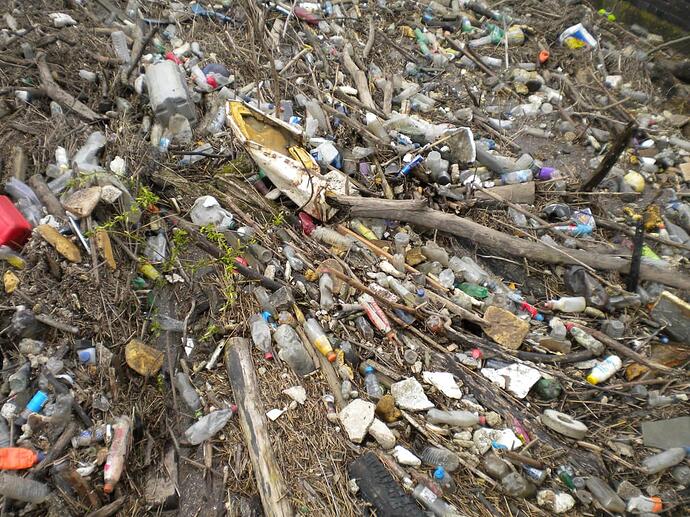There are many internet sources discussing “microplastics” from car tyres - they can’t all be discredited or wrong - here’s another:
Abstract
In recent years, marine, freshwater and terrestrial pollution with microplastics has been discussed extensively, whereas atmospheric microplastic transport has been largely overlooked. Here, we present global simulations of atmospheric transport of microplastic particles produced by road traffic (TWPs – tire wear particles and BWPs – brake wear particles), a major source that can be quantified relatively well. We find a high transport efficiencies of these particles to remote regions. About 34% of the emitted coarse TWPs and 30% of the emitted coarse BWPs (100 kt yr−1 and 40 kt yr−1 respectively) were deposited in the World Ocean. These amounts are of similar magnitude as the total estimated direct and riverine transport of TWPs and fibres to the ocean (64 kt yr−1). We suggest that the Arctic may be a particularly sensitive receptor region, where the light-absorbing properties of TWPs and BWPs may also cause accelerated warming and melting of the cryosphere.
Introduction
Global annual plastic production reached 359 million tonnes in 20181 and, consequently, plastic pollution in freshwater2, marine3 and terrestrial4 ecosystems has received a lot of attention recently. Plastics are released into the environment as macroplastic (>5 mm)5, microplastic (1 μm to 5 mm)6 and nanoplastic (<1 μm)7 particles that can fragment into smaller sizes via photodegradation, physical abrasion, hydrolysis and biodegradation8. Plastics can affect coral reefs9, marine10 and terrestrial animals11, as well as human health12,13.
An important source of plastics is road traffic emissions14,15. Kole et al.14 reported global average emissions of tyre wear particles (TWPs) of 0.81 kg year−1 per capita, about 6.1 million tonnes (~1.8% of total plastic production). Emissions of brake wear particles (BWPs) add another 0.5 million tonnes. TWPs and BWPs are produced via mechanical abrasion and corrosion16,17.
Tyres consist of a mix of elastomers such as rubber (natural and synthetic)18, carbon black, steel cord, fibres, and other organic and inorganic components used to improve their stability19; TWPs are produced by shear forces between the tread and the road pavement, generating coarse particles20, or by volatilization generating submicronic particles21. The wearing process depends on the type of tyre, road surface and vehicle characteristics, as well as on the vehicle’s state of operation22.
Most car braking systems consist of a disc or drum with either a pair of shoes or pads mounted in callipers. Brake linings consist of binders, fibres, fillers, frictional additives or lubricants and abrasives23,24,25. Thus, BWPs are a complicated mixture of metal and plastic. BWP emissions depend on the bulk friction material23,26, on the frequency and severity of braking27, speed, weight, condition and maintenance of the automobile28 and the environmental conditions23,29,30.
Transport of TWPs and BWPs via runoff and wash-out to marine and/or freshwater ecosystems has been studied31,32. However, very little is known about their dispersion in the atmosphere33,34,35 and where they are deposited, despite their health impacts in animals9,10,11,36 and humans12,37, possibly enhanced by adsorbed toxic organic compounds and heavy metals38. Greater use of plastics results in more extensive consumption of fossil fuels and, in turn, in larger emissions of greenhouse gases39 such as methane and ethylene40. Since TWPs and BWPs can be present at sizes <10 µm41, they can remain airborne for long periods of time; different types of microplastics have been detected already in remote areas42,43,44,45,46,47. Considering that they are colourful particles48, they also absorb light and thereby decrease the surface albedo of snow and ice accelerating melting, similar to black carbon (BC)49.
Here, we examine atmospheric transport and deposition of TWPs and BWPs on a global scale (see “Methods”). For simplicity we often refer to these particles jointly as road microplastics, although TWPs and BWPs are not the only microplastics that are emitted by traffic (other sources include polymer-modified bitumen used for road pavement or road marking paint). Even though TWPs and BWPs contain components other than plastics (e.g., metals), plastics are the dominant component, especially for TWPs. We also speak of microplastics50, since we only consider the particles of mean size 0.5–9.5 µm, which can remain airborne for long periods of time.




